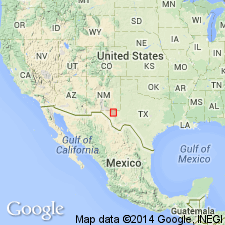
- Usage in publication:
-
- Brushy Canyon formation*
- Modifications:
-
- Principal reference
- Dominant lithology:
-
- Sandstone
- AAPG geologic province:
-
- Permian basin
Summary:
Pg. 577-579, 585 (fig. 7), 586-588, pl. 2; USGS Prof. Paper 215, p. 28-30, pl. 3, 1948 [1949]. Brushy Canyon formation of Delaware Mountain group. Characterized by many sandstone beds that are coarser grained than those elsewhere in group; individual beds are lenticular and pinch out within short distances; many sections include as many as dozen beds of sandstone of various thicknesses, but others contain only a few; sandstones extend to top of a formation. Thickness 1,000 feet. Conformably overlies Bone Spring formation with Cutoff shaly member (new) forming transition zone between; overlaps northwestward on to Bone Spring. [Age is Middle Permian (Guadalupe).]
Named from Brushy Canyon, 6 mi south-southeast of Guadalupe Peak, Culberson Co., western TX; canyon drains westward down Delaware Mountains escarpment and crosses whole thickness of formation.
Source: US geologic names lexicon (USGS Bull. 1200, p. 507).
For more information, please contact Nancy Stamm, Geologic Names Committee Secretary.
Asterisk (*) indicates published by U.S. Geological Survey authors.
"No current usage" (†) implies that a name has been abandoned or has fallen into disuse. Former usage and, if known, replacement name given in parentheses ( ).
Slash (/) indicates name conflicts with nomenclatural guidelines (CSN, 1933; ACSN, 1961, 1970; NACSN, 1983, 2005, 2021). May be explained within brackets ([ ]).

